* Here's why you need CU at least. And ideally FCU, giving you yet another six months of support and patches.

In what follows, I explicitly refer to the Lumia 930, but in principle this will also work with the Lumia 1520, and even the 830 and 735. And also the Lumia Icon. Though don't get too carried away, the specs of even older and lower end phones won't really hold up well under modern Windows 10 Mobile OS branches.
It may be that you've been playing with one of these smartphones after going through the Insiders programme and then used the Windows Device Recovery Tool (WDRT), after which your phone is taken right back to the last officially supported software, in this case Windows Phone 8.1 (hey, the phones themselves are from 2014!), so before you even start the body of this article you've got some extra work to do, getting the phone onto a branch of Windows 10 Mobile.
If you're already on Windows 10 Mobile, perhaps AU, which is how far Microsoft lets you go officially, then you can skip to step no. 4 below.
If you're back on Windows Phone 8.1, just for completeness:
1. In the Windows Phone 8.1 Store, seek out 'Upgrade Advisor', from Microsoft. Run this utility and follow the prompts to upgrade to Windows 10 Mobile. Don't worry, this is all 100% official still. Once on Windows 10 Mobile, you'll be on the very first branch of the OS, dubbed '1511' (2015, November), so don't worry too much about setting everything up and customising it, as you have a long way to go before you're done today!
2. In Settings, head for 'Updates & Security' and check for updates again - you'll see another update, this time taking you from '1511' up to a baseline build of AU.
3. Again in Settings, check again and you'll see another small patch after this (build 14393. 2068, at the time of writing), putting on the latest tweaks and security patches. Although you don't strictly need this, best to apply it anyway, just in case the OS tries installing it while you're doing other stuff below!
Your Lumia 930 is now on the latest build Anniversary Update and Microsoft would say 'Stop there, you're done!' you're ready to start the geeky fun...
4. Warning. Before going further, pay attention because here's a geek-factor warning.
- If you don't know what a 'Command Window' is or don't own a Windows PC then please don't do any of this!
- If you know what a Command Window is, own a Windows PC, and are happy looking into files and folders using Windows Explorer (or similar), then you're geeky enough and have everything you need to do the sequence below. It doesn't take long if everything goes smoothly, but I'm assuming that as you do have the geek factor then you'll not panic if something doesn't work first time and you'll work through it logically without emailing me!
______________________
5. Before doing any of this, it's worth doing a full backup in Settings/Update & Backup/Backup/Backup options - just in case. You shouldn't lose any data, but there will be the temptation once you're on CU or FCU to do a full 'reset your phone' and then you'll appreciate that there's a full backup of your apps and preferences ready and waiting.
NB. I've adapted and expanded on instructions from several sources, but principally here. Note that when running Interop Tools, you'll always get a pop-up at the start - each time, just choose 'This device', on its own, i.e. not 'This device (with provider extensions)':

6. On your Windows PC, grab a recent version of Interop Tools from here, it'll unzip to a main app and five dependencies, all in a sub-folder.

7. On your Lumia 930, enable Developer mode in Settings/Updates & Security/For Developers. Then enable Device Portal. And then toggle off 'Authentication':

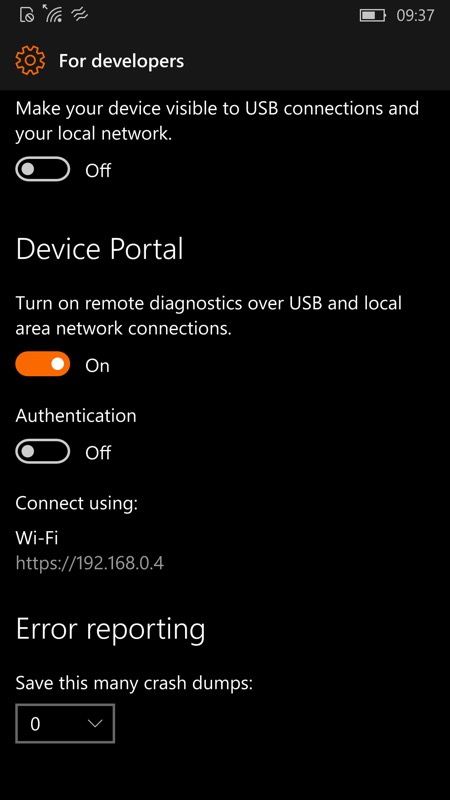 new screen
new screen
8. Access the IP quoted on your PC/laptop’s browser of choice. The IP address looks like http://192.168.0.x In your PC's browser you should now see the phone's built-in portal (bet you didn't know that was there, eh?!)
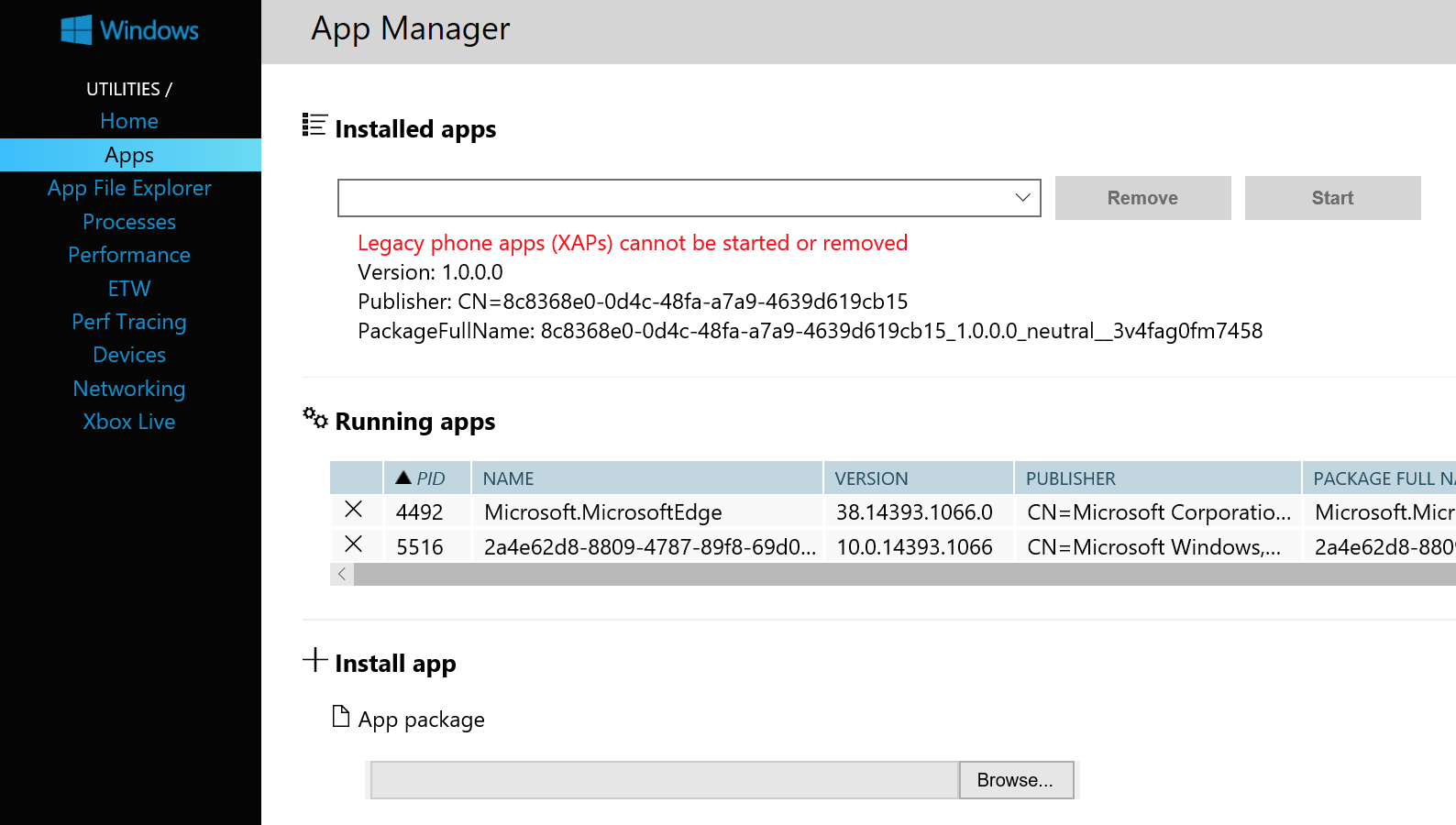
9. In the portal interface, click on 'Apps' and then scroll down to the 'Install app' section. Using the file-picking fields, select the Interop Tools app file (from step 1, above, the one you want is about 40MB and is the one without 'th1' in its filename), then scroll down a little further and add each of the five dependency files in the appropriate file picker (in each case 'Add dependency' and then click on 'Browse', etc. You should have six files selected and their paths shown.

10. Click on 'Deploy/Go' and wait a minute while Interop Tools and all the bits it needs are installed on your phone. Once done, you should see 'Interop Tools (Preview)' in your phone's app list.
11. Back on the phone, open Interop Tools and accept the various permissions asked for. Again, when you get to 'Select a provider for this application session', pick 'This device' from the four options given, and then tap on 'Use this provider'. Wait a few seconds for the utility to initialise, there's a lot going on behind the scenes - don't ever rush Interop Tools!
12. Enable 'Restore NDTKSvc'. The toggle will be set.
13. Restart the phone. Power it down, then power it up. In Interop Tools, check the Interop Unlock section again, you should see 'Restore NDTKSvc' still enabled.

14. From the hamburger menu, go to 'Registry'/'Registry Browser' and then go into 'HKEY_LOCAL_MACHINE/System/Platform/DeviceTargetingInfo'
15. Change three of the registry keys as follows:
- 'PhoneManufacturer' - change the 'Registry Value Data' from 'NOKIA' to 'MicrosoftMDG' (capitalisation is important). Tap on 'Write' (the tick control).
- 'PhoneManufacturerModelName', change this from 'RM-1045_1003' (or similar - if yours is different, then make a note of it exactly, on a piece of paper!) to 'RM-1085_11302' (mimicking a Lumia 950 XL, or RM-1116_11258 has been suggested for dual SIM devices, again mimicking a Lumia 950 XL variant). Again, tap on 'Write'.
- 'PhoneModelName', change this from 'Lumia 930' to 'Lumia 950 XL'. Tap on 'Write'.
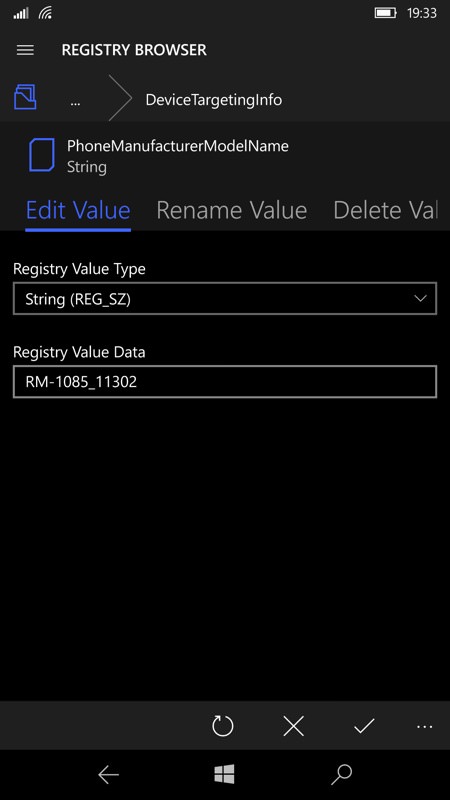
16. Go to the phone's 'Settings'/'Update'/'Check for updates', as usual, and you should see 15063.xxx, the Creators Update (branch '1703', as in '2017 March'), installing already.

17. After installation, check for updates again, to get, in sequence, the Fall Creators Update (branch '1709') baseline, and then the latest build/patch. This will all take an hour or so, so have something else productive to do while you wait!
Note that this is all genuinely uncharted territory for the Lumia 930 (or 830/1520/whatever), since even with the original Insiders programme the 930 maxed out at the Creators Update (branch '1703').
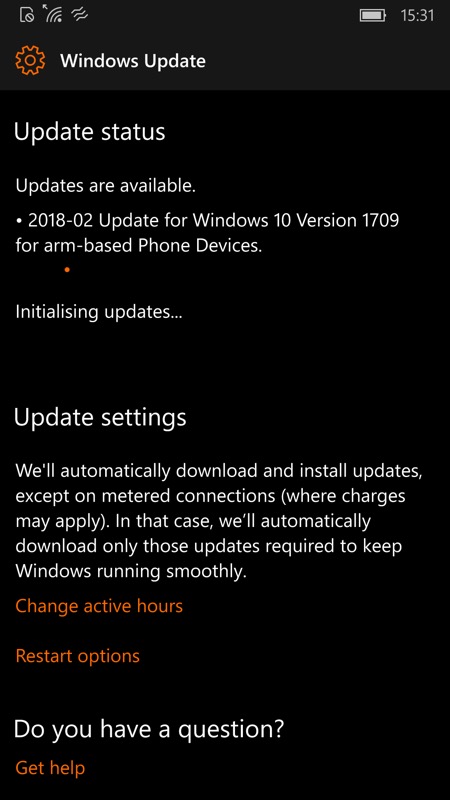
18. Once fully installed and up to date, revert the registry settings, in Interop Tools, to their original values, using the Registry Browser and the keys mentioned above. In this case (respectively), "NOKIA", "RM-1045_1003" (or similar), and "Lumia 930".
That way, any software you install that goes looking won't suddenly think your phone has Lumia 950 XL hardware! Don't worry, now that your Lumia 930 is on Fall Creators Update you'll get all the monthly security patches and fixes until Spring 2019 or beyond. Which is pretty decent for a phone that shipped in the 2014 timeframe.
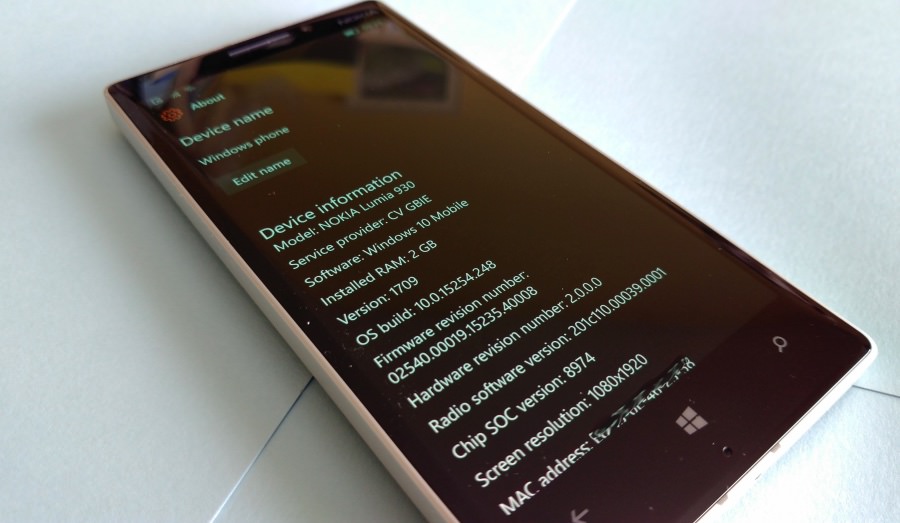
19. For completeness (and peace of mind), in 'Settings'/'Updates & Security'/'For Developers', check 'Device portal' is off again and also then set the phone's status back to just 'Windows Store apps'.
Now, all may be well at this point. All your data, the latest updates, and so on. In which case you're done.
However, if you do suspect that there are problems under the hood - after all, you have just jumped through a year's worth of OS updates in a couple of hours and the FCU may be battling with system files created under AU (and, for this full tutorial, under Windows Phone 8.1) - then I'd suggest a full 'reset your phone' in Settings/System/About, followed by signing back into your account and choosing the backup that you made earlier. Yes, it'll take ages (over 100 apps to install in the background and foreground), but it'll be worth it.
Or you could do what I often do and that's build the phone up again, installing applications as you need them, i.e. not reinstalling all the junk apps that you'd grabbed in the past 'just to try out'. A fresh start under FCU. It's up to you, anyway!
Comments welcome, especially if you think I missed a step or a subtlety that might improve this article. Please don't email me with requests for individual hand-holding though - you're in ultra-geek territory here and you need to work through all this yourself.
PS. See also my similar, but necessarily extended, tutorial on how to bring the third party Alcatel IDOl 4 Pro also up to Fall Creators Update.
